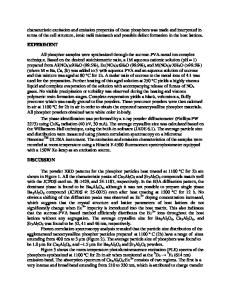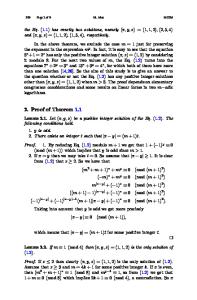Order-disorder in A 2 M 3+ M 5+ O 6 perovskites
- PDF / 1,701,709 Bytes
- 10 Pages / 576 x 792 pts Page_size
- 35 Downloads / 358 Views
Using x-ray and neutron diffraction data, the degree of order of the octahedral site cations has been determined for the perovskites Sr 2 AlNb0 6 and Sr 2 AlTa0 6 , which have been prepared by several different methods and annealed at temperatures up to 1690 °C. The degree of order generally increases with increasing synthesis temperature. The amount of cation ordering is, therefore, primarily controlled by kinetic processes and not by thermodynamic equilibrium considerations. Increased order obtained with increased heating time confirms this general kinetic limitation on the degree of order. However, annealing Sr 2 AlNb0 6 in the highest temperature region resulted in some decrease in order, presumably due to thermodynamic considerations. The cubic edge of both compounds decreases significantly with increasing order. Ordered domains are separated by antiphase boundaries which occur in high concentrations. The cubic cell edge within the ordered domains is significantly smaller than the overall cell edge when the concentration of antiphase boundaries is high. The antiphase boundaries cause significant lattice strain which generally decreases as the concentration of antiphase boundaries decreases. Results on other A 2 M 3+ M 5+ O 6 systems are briefly presented.
I. INTRODUCTION Order-disorder effects in complex oxides can significantly impact properties, yet these order-disorder effects are poorly understood in important systems such as the oxide superconductors and relaxor ferroelectrics such as Pb(Mg 1/3 Nb 2/ 3)O 31 ^ and Pb(Sc1/2Ta1/2)O3.4'5 We have chosen a series of relatively simple perovskites to study in detail the way in which cation ordering relates to synthesis conditions. Double substitution on the octahedral site of the perovskite structure leads to a large class of compounds of the type A 2 MM'O6. If the charge difference between the M and M' cation is greater than two, complete ordering of these cations is observed. Thus, perovskites of the type A 2+ M 2+ M 6+ O 6 and A 2 M 1+ M 7+ O 6 have always shown complete ordering of the M cations. However, for perovskites of the type A 2 M 3+ M 5+ O 6 , various degrees of order of the M cations are observed. The actual degree of order depends both on synthesis conditions and the particular A, M, and M' cations. Synthesis of Sr 2 AlNbO 6 (SAN) and Sr 2 AlTa0 6 (SAT) perovskites was first reported6-7 in 1963. It was shown then that various degrees of order of the octahedral site cations could be obtained depending on the synthesis conditions. Higher synthesis temperatures tended to give higher degrees of order, indicating that the degree of order was controlled by kinetics rather than by thermodynamic equilibrium. These materials have recently become of interest as substrates and dielectric interlayers for thin films of oxide superconductors.7"11 There is a good lattice match with the cuprate super2118
J. Mater. Res., Vol. 9, No. 8, Aug 1994
conductors. Also, SAN and SAT have the low dielectric constant (—10) and low dielectric loss that are needed for many a
Data Loading...











